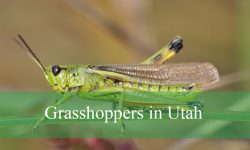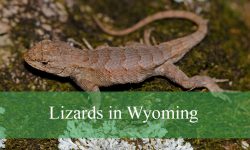Alabama’s warm, humid climate creates an ideal environment for many insects to flourish. Among them are species that can sting, bite, or carry diseases, posing real dangers to people and pets. Knowing how to identify these bugs helps prevent painful and potentially serious encounters.
Venomous Black Widow Spiders, elusive Brown Recluses, aggressive Fire Ants, and disease-spreading Ticks are just a few examples of hazardous insects found across the state. Each species has distinctive features, behaviors, and habitats that make accurate identification essential for personal safety.
This guide presents 22 of the most dangerous bugs in Alabama, complete with detailed descriptions, identification tips, and safety advice. Understanding how these insects behave and where they live makes it easier to stay protected in Alabama’s forests, backyards, and rural areas.
Types of Dangerous Bugs Found in Alabama
Black Widow Spider (Latrodectus mactans)
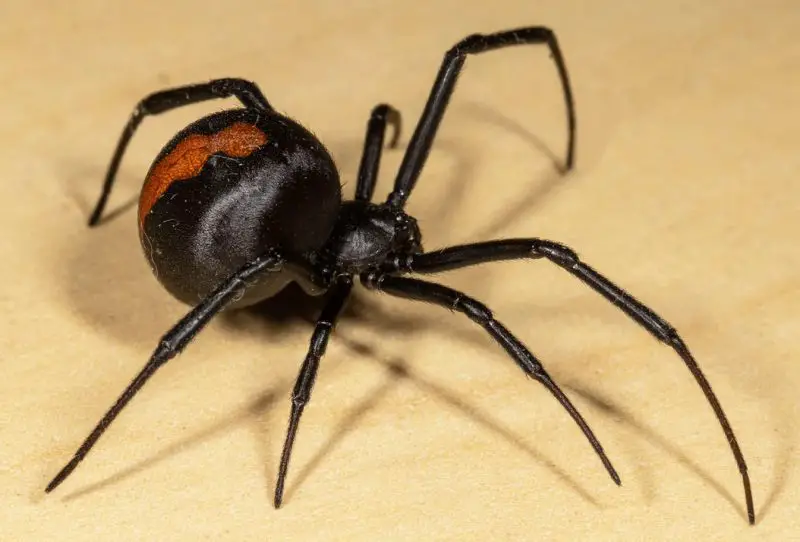
The Black Widow Spider is one of the most recognizable and feared spiders in Alabama. It has a glossy black body with a distinctive red hourglass marking on the underside of its rounded abdomen. Females are much larger than males, typically reaching about 1.5 inches (38 mm) including leg span, while males are smaller and less venomous. These spiders have slender legs and hang upside down in irregular, tangled webs, often near ground level.
Black Widows prefer dark, undisturbed areas such as woodpiles, sheds, garages, and under rocks or debris. They are nocturnal hunters, feeding on insects and other small arthropods trapped in their webs. The species thrives in Alabama’s warm and humid climate, being common in both rural and suburban areas throughout the state. They are solitary except during mating, and females are known to consume males occasionally after mating.
A bite from a Black Widow is venomous and can cause severe pain, muscle cramps, nausea, and sweating, though fatalities are extremely rare. The venom affects the nervous system, and symptoms can last for several days. Immediate medical attention is advised after a confirmed bite, especially for young children, the elderly, or those with compromised immune systems.
Although dangerous, Black Widow Spiders are not aggressive by nature and bite only when threatened or accidentally pressed against the skin. Controlling clutter, wearing gloves while handling firewood or yard debris, and sealing gaps in outdoor structures can reduce encounters. In Alabama, pest control experts frequently encounter this species due to the state’s favorable environmental conditions.
Brown Recluse Spider (Loxosceles reclusa)
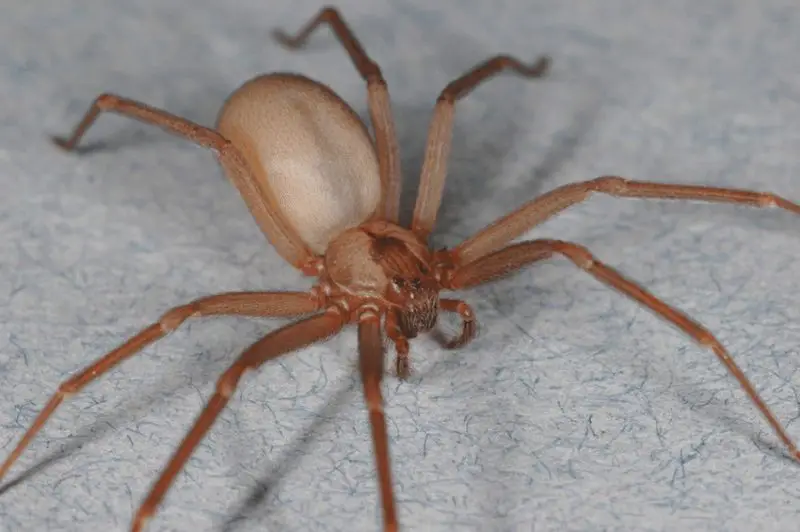
The Brown Recluse Spider is another venomous arachnid found throughout Alabama, easily recognized by its violin-shaped marking on the cephalothorax. The body measures about 0.25 to 0.5 inches (6–12 mm) in length, with long, delicate legs and a light to dark brown coloration. Unlike many other spiders, it has six eyes arranged in three pairs, a key identifying trait.
Brown Recluses prefer dry, dark, and secluded areas such as basements, closets, attics, and behind furniture. Outdoors, they can be found under rocks, bark, and woodpiles. These spiders are nocturnal and feed on small insects. They do not build visible webs to catch prey; instead, they hunt at night and use their silk for retreats and egg sacs. The species is well adapted to Alabama’s climate and is more common in the northern and central parts of the state.
The venom of the Brown Recluse contains necrotic toxins that can cause serious skin damage. A bite may initially go unnoticed but can develop into a painful ulcer or open sore within hours or days. In severe cases, the tissue may die and require medical treatment or even surgery. However, most bites heal with minimal medical care if promptly cleaned and treated.
Despite their reputation, Brown Recluses are not aggressive and usually bite only when trapped against the skin. Prevention includes reducing clutter, sealing cracks, and shaking out clothes and shoes before wearing them. In Alabama homes, pest management and sanitation play a major role in limiting their population.
Eastern Yellowjacket (Vespula maculifrons)
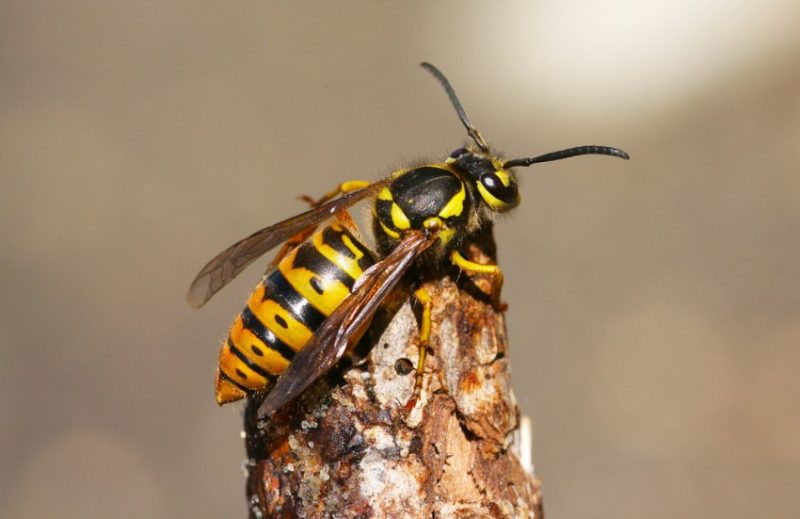
The Eastern Yellowjacket is one of Alabama’s most aggressive stinging insects. It has a black-and-yellow patterned body measuring about 0.5 inches (12 mm) long, with a distinctive, narrow waist and smooth body. Unlike bees, yellowjackets have a smooth stinger that allows them to sting repeatedly without dying.
These insects build their nests underground or in cavities such as wall voids, tree stumps, and old rodent burrows. Nests can contain thousands of individuals by late summer, making them especially defensive during this period. Eastern Yellowjackets are social insects with a structured colony, including a queen, workers, and drones. They feed on sugary substances and proteins, scavenging around garbage, outdoor picnics, and food sources in residential areas.
Stings from Eastern Yellowjackets are extremely painful and can cause redness, swelling, and itching. Multiple stings or allergic reactions can lead to severe symptoms such as difficulty breathing, dizziness, or anaphylaxis, requiring emergency medical care. Their aggressive nature makes them one of the most dangerous wasp species in Alabama, particularly when their nest is disturbed.
These insects are most active during the summer and early fall when colony numbers peak. Controlling food waste, sealing trash bins, and avoiding wearing strong fragrances outdoors can reduce encounters. Professional pest control is recommended for nest removal due to the high risk of repeated stings.
Bald-faced Hornet (Dolichovespula maculata)
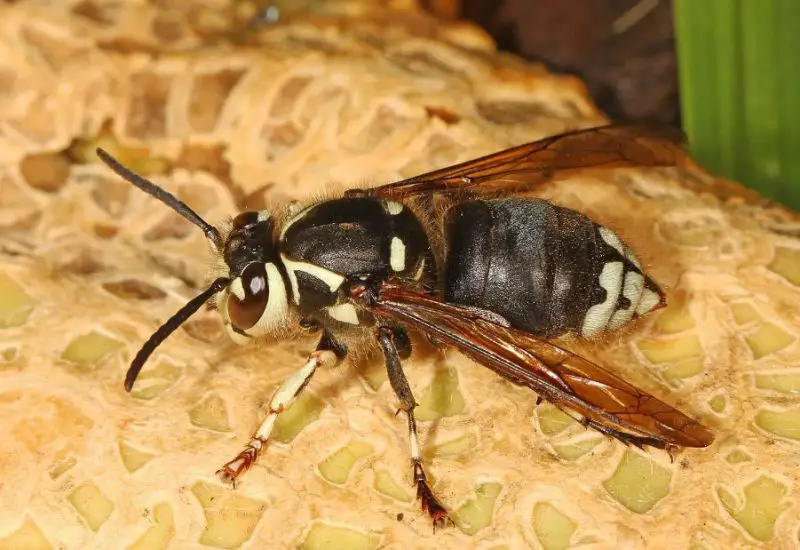
The Bald-faced Hornet, though technically a type of yellowjacket, is a large, striking black-and-white wasp found throughout Alabama. Adults measure about 0.75 inches (19 mm) long, with a mostly black body, white facial markings, and clear wings. Their paper nests are often spherical and can reach the size of a basketball, hanging from trees, shrubs, or building eaves.
These hornets are social and live in colonies that can contain up to 400 workers. They are most active from late spring through early fall, feeding on nectar, fruit, and other insects. Despite their name, Bald-faced Hornets are beneficial in controlling pest insect populations. In Alabama, they are commonly found in wooded areas, parks, and suburban neighborhoods with plenty of trees.
Their sting is potent and painful, containing venom that causes immediate burning and swelling. While not typically lethal, multiple stings or allergic reactions can be dangerous. Bald-faced Hornets are highly defensive of their nests and will attack in swarms if they sense a threat. Unlike bees, they can sting multiple times without dying.
To avoid confrontation, people should maintain a safe distance from visible nests and seek professional help for removal. In Alabama’s warm climate, these hornets thrive through the summer and often rebuild new colonies each year. Despite their aggressive defense behavior, they play an essential ecological role by preying on flies and other pests.
Paper Wasp (Polistes spp.)
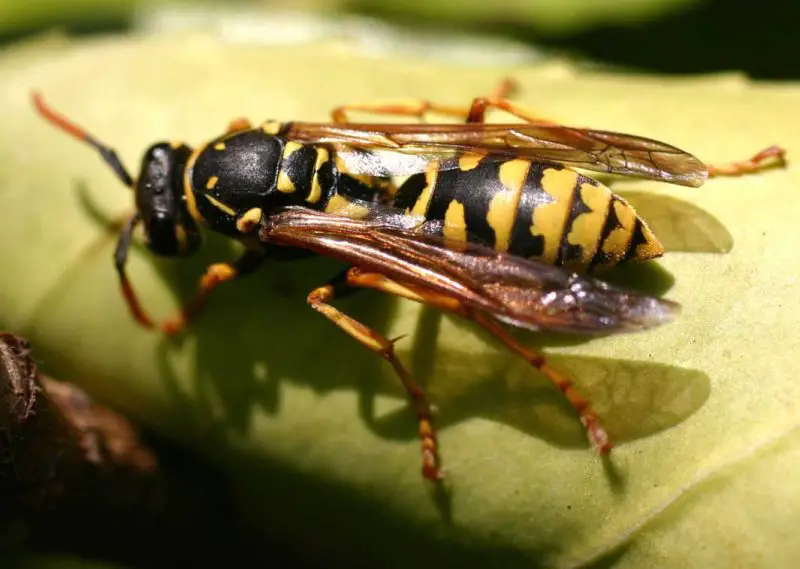
The Paper Wasp is a common and easily recognizable stinging insect found throughout Alabama. These wasps have slender, elongated bodies ranging from 0.5 to 1 inch (12–25 mm) in length, with long legs that dangle noticeably during flight. Their coloration varies by species but generally includes brown, black, yellow, or reddish markings. The name “paper wasp” comes from the distinctive papery nests they construct, made by chewing plant fibers mixed with saliva to form a paper-like material.
Paper Wasps are social insects that build open, umbrella-shaped nests often found under eaves, porches, decks, and tree branches. Each colony typically contains a few dozen individuals led by a queen. They are active during Alabama’s warm months, especially in spring and summer when they build new nests and raise young. Paper Wasps feed on caterpillars, flies, and nectar, making them beneficial for natural pest control in gardens and agricultural settings.
Their sting is painful and can cause redness, swelling, and itching, though it’s rarely life-threatening unless the person is allergic. Unlike bees, Paper Wasps can sting multiple times. They are defensive rather than aggressive, usually stinging only when their nest is disturbed. A colony may attack in unison if they sense vibrations or movement near the nest.
In Alabama, Paper Wasps are particularly common in suburban and rural areas with abundant vegetation. To avoid stings, homeowners should inspect outdoor structures for nests during spring and avoid sudden movements near wasp activity. Removing nests should be done at night or by professional pest control experts.
Fire Ant (Solenopsis invicta)
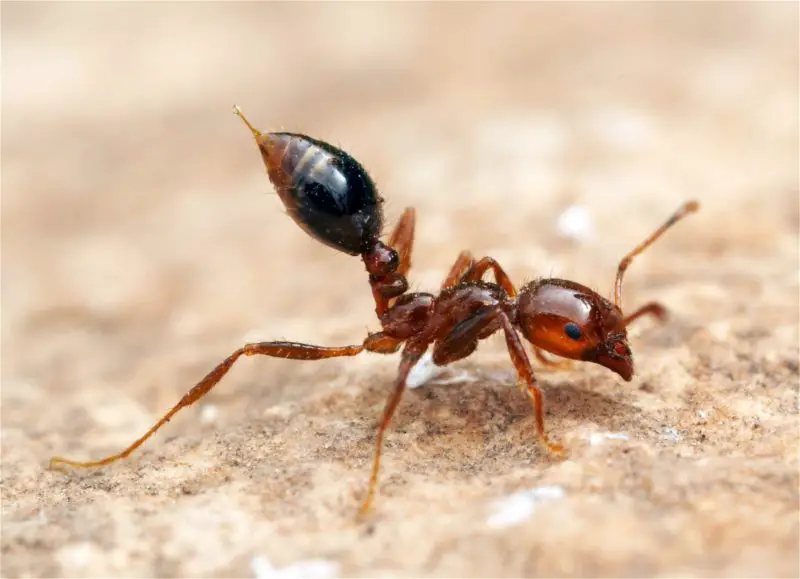
The Fire Ant, specifically the Red Imported Fire Ant, is one of Alabama’s most aggressive and problematic pests. These reddish-brown ants measure about 1/8 to 1/4 inch (3–6 mm) in length and are known for their fiery sting. They form large mounds that can reach up to 18 inches (45 cm) high and are often found in sunny, open areas such as lawns, fields, and roadsides.
Fire Ant colonies can contain hundreds of thousands of individuals and multiple queens, making them difficult to eliminate once established. The ants are highly territorial and will swarm rapidly when their mound is disturbed. They feed on a variety of substances, including insects, seeds, and food scraps, and are particularly drawn to electrical equipment and moisture sources. In Alabama’s warm and humid environment, Fire Ants thrive year-round, especially in southern regions.
Their sting injects venom that causes immediate burning pain followed by red pustules or blisters. Multiple stings can lead to severe allergic reactions, including anaphylaxis in sensitive individuals. In addition to their medical threat, Fire Ants damage crops, lawns, and electrical wiring, costing millions annually in control and repair efforts.
Controlling Fire Ant populations in Alabama requires consistent treatment using baits, mound drenches, or professional extermination. Avoiding barefoot walking in infested areas and promptly treating visible mounds helps prevent stings. Awareness and management are essential since Fire Ants continue to spread across the southeastern United States.
Mosquito (Aedes aegypti & Aedes albopictus)
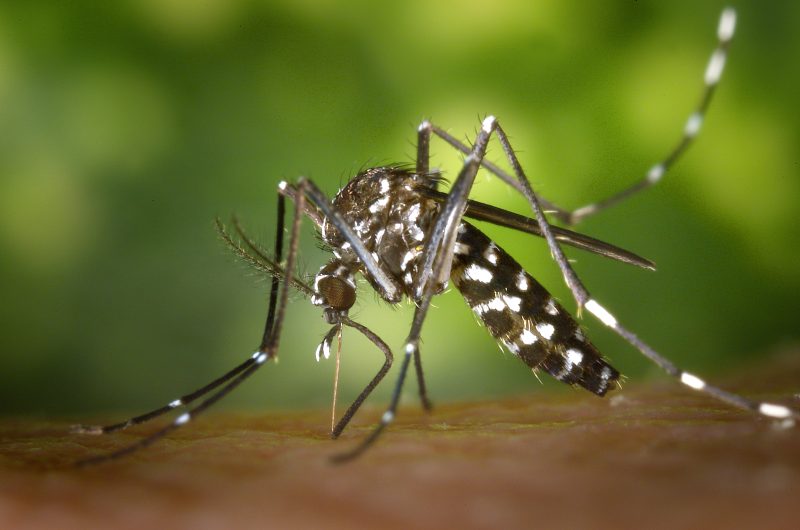
Mosquitoes, particularly Aedes aegypti (Yellow Fever Mosquito) and Aedes albopictus (Asian Tiger Mosquito), are among the most dangerous insects in Alabama due to their role in spreading diseases. These small, slender insects measure about 0.1 to 0.25 inches (2.5–6 mm) long, with long legs and narrow wings. The Aedes aegypti species is dark with white markings on its legs and a lyre-shaped pattern on its thorax, while Aedes albopictus has striking black-and-white striped legs and a single white stripe running down its back.
Both species breed in standing water, including puddles, flowerpots, gutters, and birdbaths. Alabama’s humid climate and frequent rainfall make it an ideal environment for mosquito breeding almost year-round. The females require blood meals for egg development and prefer biting during the day, particularly early morning and late afternoon. They are known vectors for diseases such as dengue, Zika virus, chikungunya, and West Nile virus.
Mosquito bites cause itching, redness, and swelling due to an allergic reaction to their saliva. In some cases, excessive scratching can lead to secondary infections. The greatest danger comes from their potential to transmit viruses to humans and animals. Public health departments in Alabama routinely monitor mosquito populations to prevent outbreaks.
Preventing mosquito bites involves using insect repellent, wearing long sleeves, and eliminating standing water around homes. Installing window screens and using mosquito traps can also reduce infestations. Despite their size, mosquitoes remain one of Alabama’s most significant health threats.
Tick (Lone Star Tick – Amblyomma americanum)
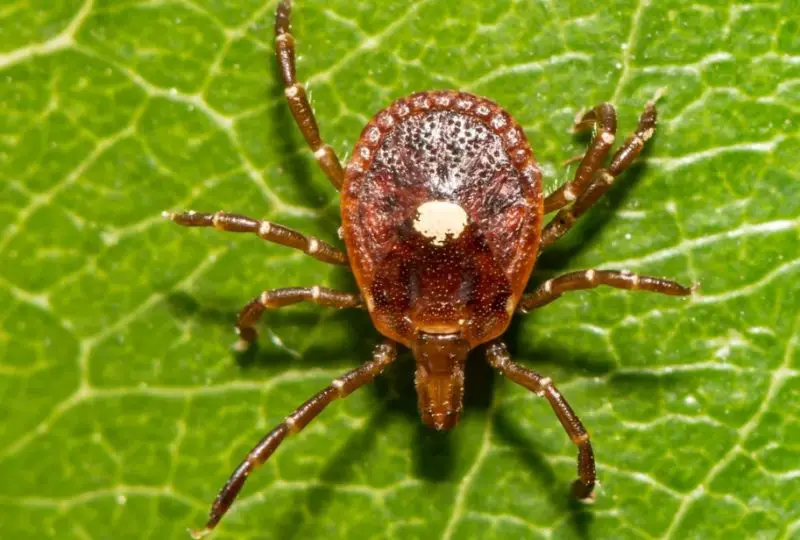
The Lone Star Tick is a widespread and medically significant tick species in Alabama. Adult females are easily identified by a single silvery-white spot on their reddish-brown back, giving the species its name. Males are smaller and lack this distinct marking. Adults measure about 1/8 inch (3 mm) when unfed but can expand considerably after feeding. They have eight legs and a flattened, oval body designed for clinging tightly to hosts.
Lone Star Ticks are found in wooded areas, grassy fields, and along animal trails throughout Alabama. They are most active from early spring through late summer and feed on mammals, birds, and humans. These ticks do not climb high vegetation but wait on low plants or leaf litter, sensing carbon dioxide and movement from potential hosts.
The bite of a Lone Star Tick can cause irritation, redness, and swelling, but their greatest threat lies in disease transmission. They are known carriers of Ehrlichiosis, Southern Tick-Associated Rash Illness (STARI), and potentially the Alpha-gal syndrome, which causes red meat allergies in humans. The tick’s saliva contains compounds that may provoke allergic or immune responses.
Preventive measures include wearing long clothing when hiking, using tick repellents containing DEET or permethrin, and checking skin and pets after outdoor activity. In Alabama’s warm climate, ticks remain active for much of the year, so year-round vigilance is essential to avoid tick-borne diseases.
American Dog Tick (Dermacentor variabilis)
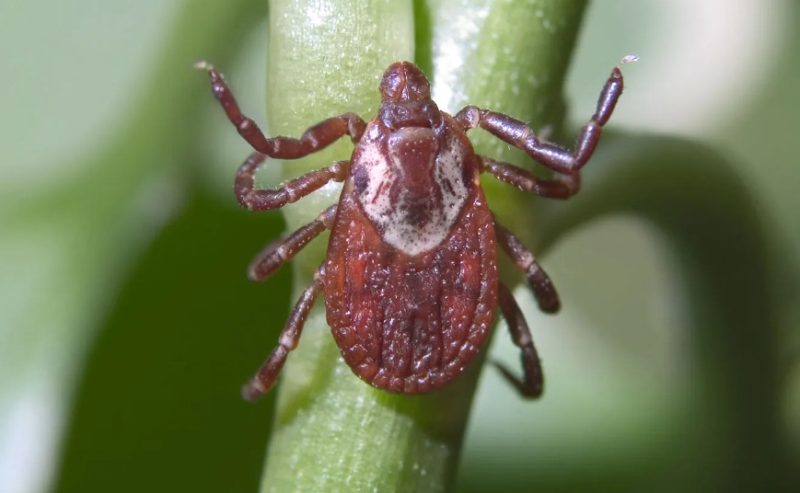
The American Dog Tick is another common tick species found across Alabama, often infesting dogs and wildlife but occasionally biting humans. It has a dark brown body with gray or whitish markings on its scutum (the shield-like area near its head). Adults measure about 3/16 inch (5 mm) long when unfed and can swell to over half an inch (13 mm) after feeding on blood.
This tick species prefers open fields, grassy areas, and trails frequented by animals. It is most active during spring and early summer when temperatures and humidity are favorable. The American Dog Tick waits on vegetation, attaching to passing hosts such as dogs, raccoons, or humans. In Alabama, it is especially prevalent in suburban and rural regions with abundant wildlife.
The American Dog Tick is a known vector for diseases such as Rocky Mountain Spotted Fever (RMSF) and Tularemia. A bite may go unnoticed at first, but the tick can remain attached for several days, transmitting pathogens through its saliva. Symptoms of infection can include fever, rash, headache, and muscle pain. Prompt removal of ticks and medical attention are critical for prevention and treatment.
To reduce risk, individuals should avoid tall grass, wear light-colored clothing, and use tick repellents. Regularly inspecting pets and applying tick prevention treatments are vital in Alabama’s tick-prone regions. Although not as numerous as the Lone Star Tick, the American Dog Tick poses significant health risks due to its disease-carrying potential.
Deer Tick / Black-legged Tick (Ixodes scapularis)
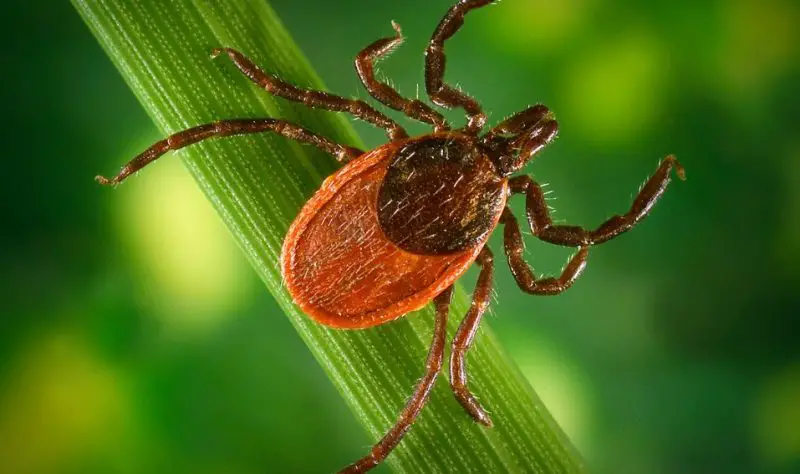
The Deer Tick, also known as the Black-legged Tick, is one of Alabama’s most medically concerning parasites due to its ability to transmit Lyme disease and other tick-borne illnesses. Adult females are easily recognized by their reddish-brown bodies and dark, shield-like scutum near the head. Males are smaller and darker, typically measuring about 1/8 inch (3 mm) long, while engorged females can swell to nearly 1/2 inch (12 mm) after feeding.
Deer Ticks thrive in wooded and brushy environments with plenty of leaf litter and humidity. They are most active during the cooler months of spring and fall but can survive year-round in Alabama’s mild climate. These ticks often attach to deer, rodents, and dogs, using them as hosts to complete their life cycle. Humans can become incidental hosts when passing through infested areas, especially along forest edges and trails.
The bite of a Deer Tick is usually painless and often goes unnoticed for hours or even days. However, the tick’s saliva can transmit dangerous pathogens, including Borrelia burgdorferi (which causes Lyme disease), Anaplasmosis, and Babesiosis. The hallmark sign of Lyme disease is a “bull’s-eye” rash accompanied by fever, fatigue, and joint pain. Early medical treatment with antibiotics is crucial to prevent long-term complications.
To avoid bites, wear long clothing, use repellents containing DEET or permethrin, and inspect your body and pets after outdoor activity. In Alabama, where deer populations are high, the Black-legged Tick remains a persistent health threat, particularly in forested and suburban areas.
Horsefly (Tabanus spp.)
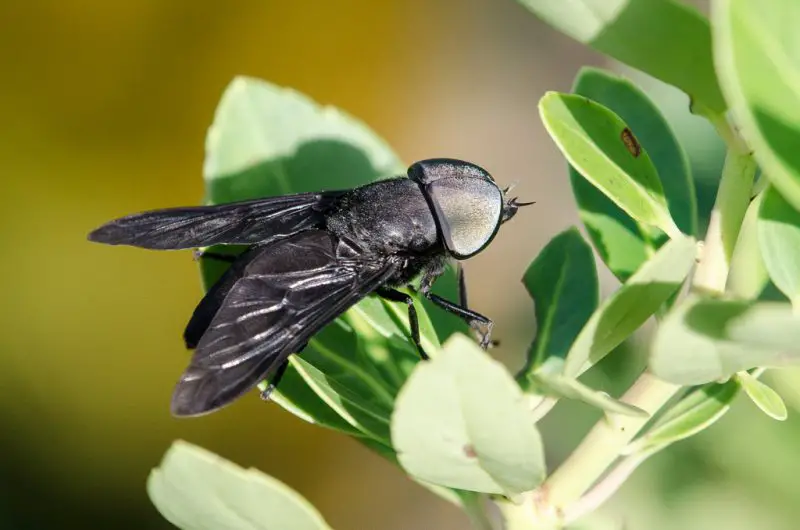
The Horsefly is a large, fast-flying insect known for its painful bite and relentless pursuit of blood meals. Females are the biters, measuring about 0.5 to 1 inch (13–25 mm) in length, with broad heads and large, colorful eyes that often show iridescent patterns. Their bodies are robust, gray or brown, with clear or slightly smoky wings. Males, on the other hand, feed on nectar and do not bite.
Horseflies are found across Alabama in humid, sunny environments such as pastures, wetlands, and wooded edges. They are most active during warm summer months and are especially common near livestock and water sources. Females use sharp mouthparts to cut the skin and feed on blood, which they need to reproduce. Their persistence and painful bites make them a serious nuisance to both humans and animals.
Although Horsefly bites are not venomous, they can cause intense pain, swelling, and itching. Some people may develop allergic reactions or secondary infections if the bite is scratched. More concerningly, Horseflies can transmit diseases such as equine infectious anemia and tularemia among animals, though human transmission is rare.
Preventing Horsefly bites in Alabama involves wearing protective clothing, using insect repellents, and avoiding heavily infested areas during peak daytime activity. Traps and repellents around barns and yards can also reduce populations. Because of Alabama’s warm climate, Horseflies remain active longer than in northern states, creating ongoing discomfort for outdoor workers and livestock owners.
Deer Fly (Chrysops spp.)
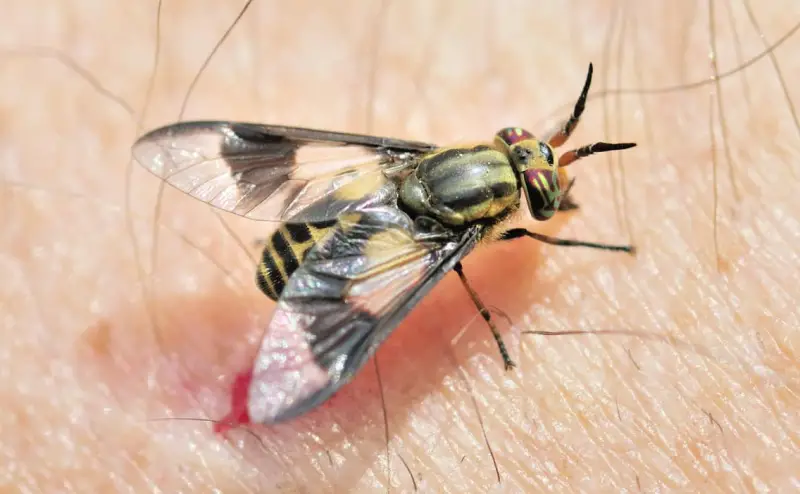
The Deer Fly is another blood-feeding pest that plagues Alabama’s outdoor environments. Smaller than horseflies, they typically measure about 1/4 to 1/2 inch (6–13 mm) long and have patterned wings with yellow or black bands. Their bright, iridescent eyes and quick flight make them easy to identify when they swarm around people or animals.
Deer Flies thrive in moist, wooded, or marshy areas and are most active from late spring through early fall. They are visual hunters, attracted to movement, dark colors, and carbon dioxide. Like Horseflies, only the females bite, using scissor-like mouthparts to slice the skin before feeding on blood. They prefer mammals such as deer, cattle, and humans, making outdoor activities in Alabama’s forests and lakeside areas uncomfortable during peak season.
Their bites are painful, causing immediate burning and sometimes bleeding. The wounds may swell, itch, and become infected if not cleaned properly. Although rare, Deer Flies can transmit Francisella tularensis, the bacterium responsible for tularemia. The risk increases in rural and wetland regions of Alabama where wildlife hosts are abundant.
Protective measures include wearing light-colored clothing, using DEET-based repellents, and avoiding heavily wooded areas during the hottest parts of the day. In Alabama’s warm, humid environment, Deer Flies can be active for months, making them one of the state’s most annoying summer pests.
Blister Beetle (Meloidae family)
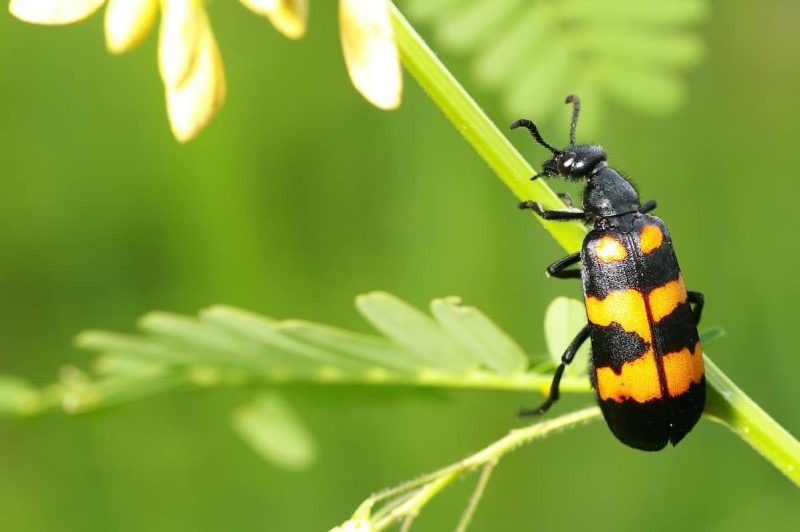
Blister Beetles are striking yet dangerous insects found throughout Alabama, particularly in agricultural areas. They are slender, soft-bodied beetles ranging from 0.5 to 1 inch (12–25 mm) long, with colors that vary from black and gray to metallic green or striped patterns. Despite their attractive appearance, they secrete a toxic chemical called cantharidin, which can cause severe skin irritation and blistering upon contact.
These beetles are typically found on flowering plants, feeding on leaves, blossoms, and pollen. In Alabama, they are often associated with alfalfa, soybeans, and clover fields. Larvae are beneficial in that they feed on grasshopper eggs, but adults can cause significant damage to crops and pose risks to humans and livestock.
Blister Beetle exposure occurs when humans handle them or when livestock accidentally ingest beetle-contaminated hay. The toxin can cause painful blisters on skin or mucous membranes and, in severe cases, poisoning in animals. Horses are especially vulnerable, as even a few beetles in their feed can lead to colic, ulcers, or death.
To prevent contact, avoid crushing beetles with bare hands and inspect forage crops carefully before harvesting. In Alabama, Blister Beetles are most active during midsummer when warm temperatures and abundant vegetation favor their reproduction and feeding cycles.
Velvet Ant “Cow Killer” (Dasymutilla occidentalis)
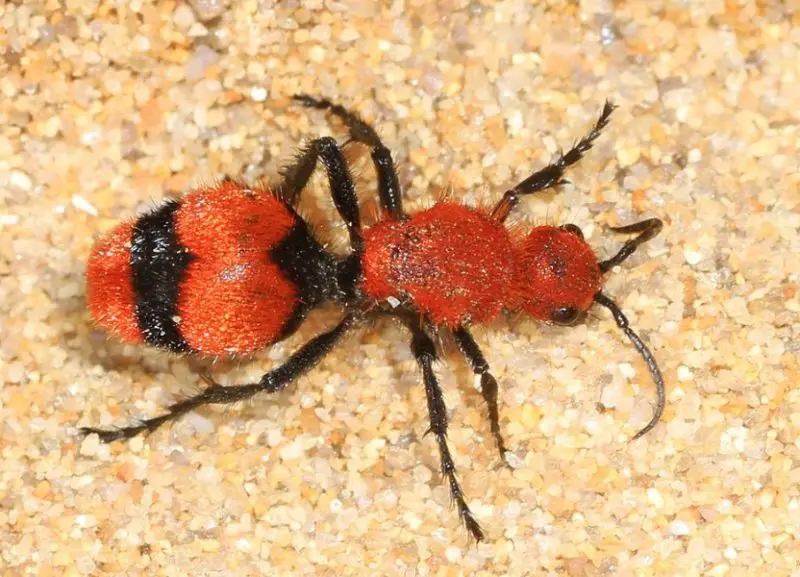
The Velvet Ant, commonly called the “Cow Killer”, is actually a type of wingless wasp rather than a true ant. Found throughout Alabama, females are easily identified by their dense, velvety red-orange and black hair, giving them a striking appearance. They range from 0.75 to 1 inch (19–25 mm) long and are among the largest wasps in North America. Males have wings, while females are wingless and known for their powerful sting.
Velvet Ants inhabit sandy, open environments such as pastures, pine forests, and gardens. They are solitary insects, often seen running quickly across the ground in search of ground-nesting bee or wasp burrows, where they lay their eggs. The larvae are parasitic, feeding on the developing pupae of their host. Although they are not aggressive, their sting is extremely painful, earning them the nickname “Cow Killer.”
The sting of a Velvet Ant can cause intense, burning pain and localized swelling, though it is not lethal to humans. Unlike bees, they can sting repeatedly and will do so if handled or stepped on. They also emit a loud squeaking sound when threatened as a defensive warning. In Alabama’s hot summers, encounters are frequent due to their preference for dry, sandy habitats.
To avoid stings, wear closed-toe shoes outdoors and avoid handling these insects. Although their sting is infamous, Velvet Ants are beneficial predators that help control populations of other ground-nesting wasps. Their vivid coloration serves as a warning to potential predators, making them a striking yet formidable part of Alabama’s insect fauna.
Scorpion (Centruroides vittatus – Striped Bark Scorpion)
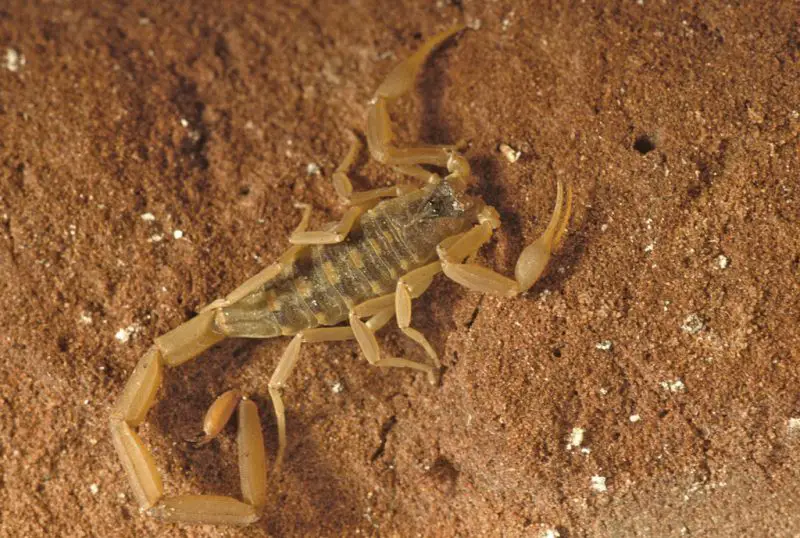
The Striped Bark Scorpion (Centruroides vittatus) is the most common scorpion species found in Alabama. It has a slender, tan to yellowish-brown body measuring 2–3 inches (5–7.5 cm) long, with two dark longitudinal stripes running down its back. Its tail ends in a curved stinger, and it uses a pair of pincers to grasp prey. Although intimidating, it is not considered deadly to humans.
These scorpions prefer warm, dry habitats such as under rocks, logs, and bark, as well as inside basements, attics, and crawl spaces. In Alabama, they are most active during the night and seek moisture and shelter during the hot summer months. They feed on insects and spiders, using their venom to paralyze prey before consuming it.
The sting of the Striped Bark Scorpion causes sharp pain, redness, and swelling at the site. While it may cause numbness or tingling in some cases, it is rarely serious unless the victim is allergic. Young children and elderly individuals may experience more severe reactions, including nausea or muscle spasms.
To prevent encounters, seal cracks in foundations, reduce clutter, and check shoes or bedding before use. In Alabama’s climate, these scorpions are common in both rural and suburban areas, often entering homes seeking cooler or more humid conditions. Though feared for their sting, they play a valuable role in controlling pest insects.
Kissing Bug (Triatoma sanguisuga)
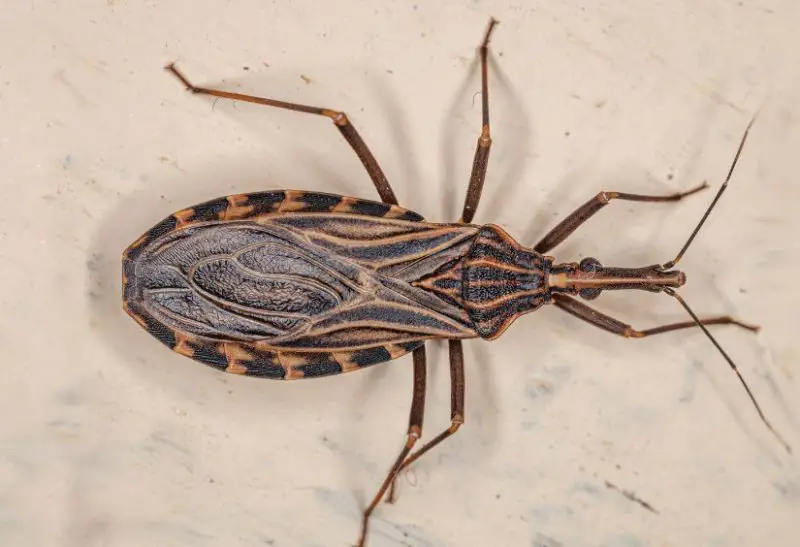
The Kissing Bug (Triatoma sanguisuga) is a nocturnal blood-feeding insect found in Alabama and other southern U.S. states. It is a large, flat-bodied bug ranging from 0.75 to 1 inch (19–25 mm) long with dark brown or black coloration and orange or red markings along the edges of its abdomen. It has a distinct, cone-shaped head and long, piercing mouthparts adapted for sucking blood.
Kissing Bugs are primarily found in rural and wooded areas, hiding during the day under porches, rocks, or within animal nests. At night, they are attracted to lights and carbon dioxide, which leads them into human dwellings. They earned their name because they often bite humans near the mouth or eyes while sleeping. In Alabama, these insects are most active during late spring and summer.
The main concern with Kissing Bugs is their ability to transmit Chagas disease, caused by the parasite Trypanosoma cruzi. Although not all individuals are infected, the risk exists when feces containing the parasite enter bite wounds or mucous membranes. Bites themselves cause itching, redness, and swelling, and some people may develop allergic reactions to their saliva.
Preventive measures include sealing cracks in homes, using bed nets, and keeping outdoor lights minimal at night. Regular pest control and keeping pets indoors at night can reduce encounters. While Chagas disease transmission is rare in Alabama, Kissing Bugs remain an emerging health concern due to their expanding range and potential as disease vectors.
Assassin Bug (Reduviidae family)
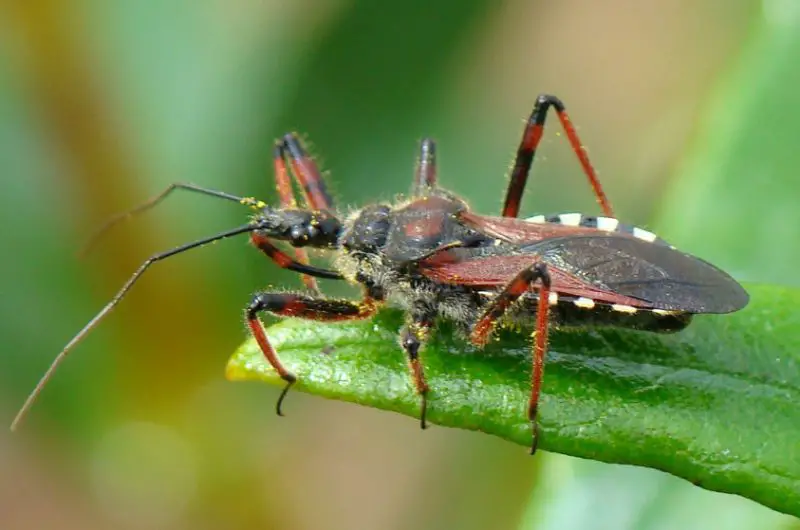
The Assassin Bug, part of the Reduviidae family, is a diverse group of predatory insects known for their stealth and deadly hunting technique. Most species measure between 0.5 and 1 inch (12–25 mm) long, with elongated heads, narrow bodies, and powerful, curved proboscises used for piercing and sucking the fluids of their prey. They vary in color from brown to black and often have orange or red markings.
Assassin Bugs inhabit gardens, forests, and fields throughout Alabama, thriving in warm environments where insect prey is plentiful. They play an important ecological role by feeding on pest species such as caterpillars, flies, and beetles. They ambush or actively hunt prey, injecting venom through their beak that liquefies internal tissues for easy consumption. The Wheel Bug (Arilus cristatus) is one of Alabama’s largest and most recognizable Assassin Bugs, featuring a spiny wheel-like crest on its back.
Despite being beneficial predators, Assassin Bugs can inflict painful bites on humans if handled or threatened. Their venom causes sharp burning pain, swelling, and numbness that can last for days. The bite is not fatal but can leave a lingering sore or scar. Unlike the Kissing Bug, most Assassin Bugs do not feed on blood and are not known disease vectors.
To coexist safely, avoid handling these insects and encourage them to control pests naturally. In Alabama’s gardens and agricultural landscapes, Assassin Bugs serve as valuable allies, helping maintain ecological balance while occasionally reminding humans of their defensive bite.
Stink Bug (Halyomorpha halys)
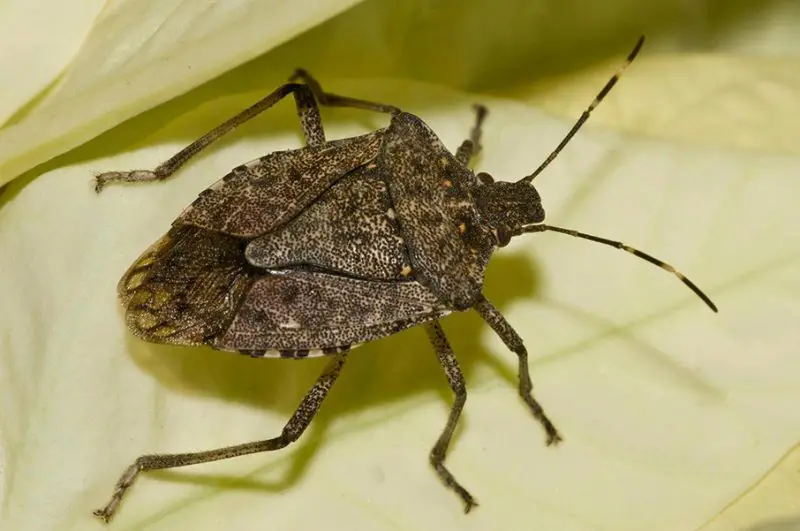
The Stink Bug (Halyomorpha halys), also known as the Brown Marmorated Stink Bug, is an invasive pest species widely established across Alabama. Adults are shield-shaped, about 0.6 inches (15 mm) long, and mottled brown with light and dark banding on their antennae and legs. When threatened or crushed, they emit a strong, unpleasant odor from glands located on their abdomen—hence their name.
Originally native to Asia, Stink Bugs were introduced to the U.S. in the 1990s and have since spread throughout the Southeast. In Alabama, they are active from spring through fall, feeding on fruits, vegetables, and ornamental plants. They use piercing-sucking mouthparts to extract plant sap, causing damage such as scarring, deformities, and reduced crop yields. They are notorious agricultural pests, particularly affecting peaches, soybeans, and corn.
During colder months, Stink Bugs seek shelter indoors, entering homes through cracks, vents, and windows. While harmless to humans, they become a nuisance by gathering in large numbers and releasing foul odors when disturbed. Their resilience and adaptability make them difficult to eradicate once established in an area.
Preventing infestations involves sealing entry points, reducing outdoor lighting at night, and using traps or vacuuming them when found indoors. In Alabama’s mild winters, they can remain active longer than in northern states, posing ongoing challenges to both homeowners and farmers.
Chigger (Trombiculidae family)
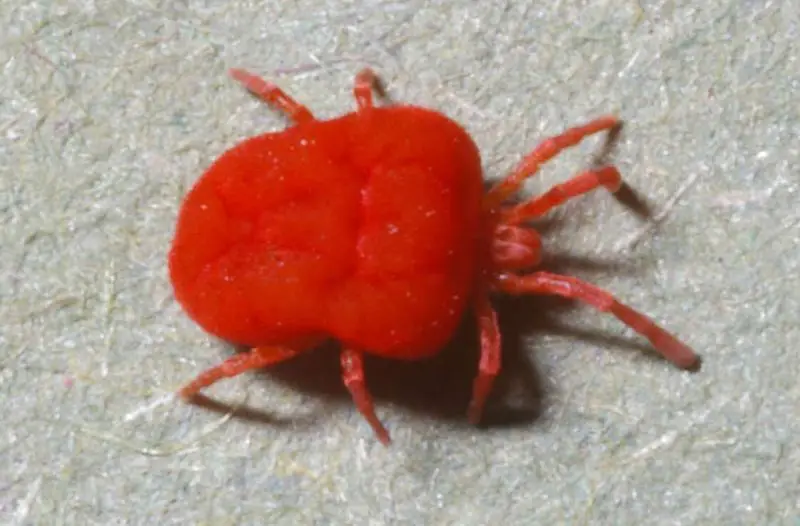
Chiggers are the larval stage of mites belonging to the Trombiculidae family, and they are notorious for their intensely itchy bites. These microscopic, red or orange mites measure less than 0.02 inches (0.5 mm) long and are barely visible to the naked eye. Despite their small size, their bites can cause extreme discomfort and skin irritation lasting for days.
Chiggers inhabit grassy fields, forests, and moist areas across Alabama. They are most active from late spring through early fall when temperatures and humidity are high. The larvae attach themselves to mammals, birds, and even humans, feeding on skin cells rather than blood. They inject digestive enzymes into the skin, which cause cell breakdown and form red, itchy welts, commonly around the ankles, waistline, or behind the knees.
Although chigger bites are not dangerous or infectious, the itching can be severe and lead to secondary infections from scratching. The irritation may last a week or more, with welts sometimes appearing in clusters or lines. Fortunately, adult chiggers are harmless and live freely in soil, feeding on plant matter.
Prevention in Alabama involves wearing long sleeves, tucking pants into socks, and applying insect repellent containing DEET or permethrin before outdoor activities. After spending time in grassy areas, showering and washing clothes promptly can help remove any chiggers before they attach. These tiny pests are a perennial nuisance across the state, particularly during Alabama’s hot, humid summers.
Giant Water Bug (Lethocerus americanus)
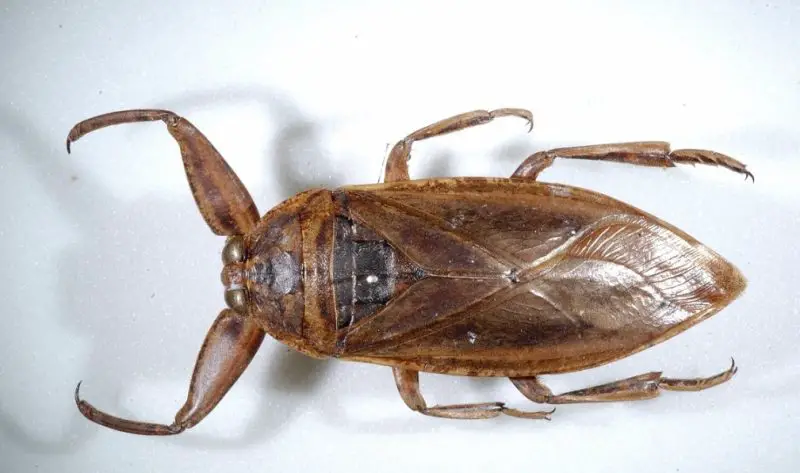
The Giant Water Bug (Lethocerus americanus), sometimes called “Toe-biter,” is one of the largest aquatic insects in Alabama. Adults can reach lengths of up to 2.5 inches (6.5 cm) and have broad, flattened brown bodies adapted for life underwater. They possess strong front legs for grasping prey and short, pointed beaks used for injecting digestive enzymes into their victims.
These insects inhabit ponds, lakes, slow-moving rivers, and wetlands throughout Alabama. They are ambush predators that feed on aquatic insects, fish, tadpoles, and even small amphibians. By remaining still and camouflaged among vegetation, they wait patiently before seizing their prey. They are also known to fly toward lights at night, sometimes startling unsuspecting humans.
While Giant Water Bugs do not transmit disease, they can deliver a painful bite if handled carelessly. The bite, often described as feeling like a bee sting, can cause temporary swelling and numbness. Despite their intimidating appearance and nickname, they are not aggressive and generally bite only in self-defense.
In Alabama’s diverse aquatic ecosystems, Giant Water Bugs play an important role as top invertebrate predators, helping maintain ecological balance. Avoid handling them directly, especially near outdoor lights or when wading in shallow water at night. Their unique biology and predatory habits make them one of the more fascinating yet formidable insects in the state.
Cicada Killer Wasp (Sphecius speciosus)
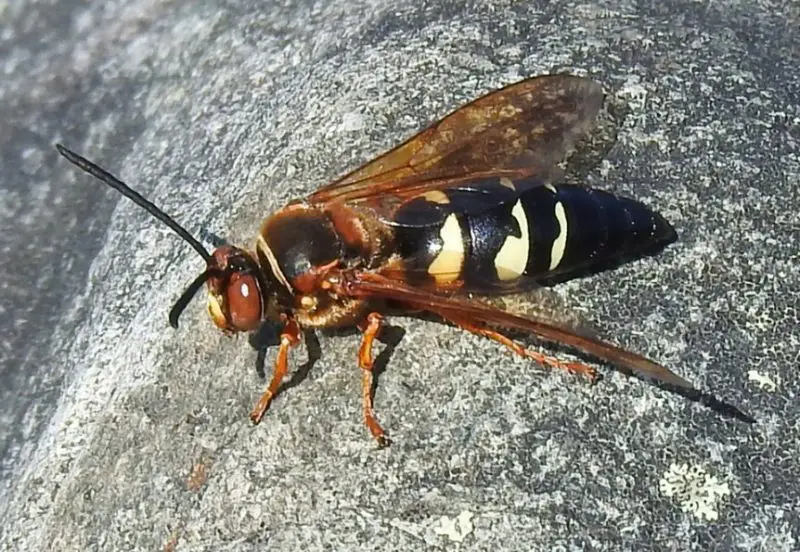
The Cicada Killer Wasp (Sphecius speciosus) is one of Alabama’s largest wasps and one of the most misunderstood. Females can reach up to 2 inches (5 cm) long, with striking black and yellow markings and reddish-brown wings. Despite their intimidating appearance, they are not aggressive toward humans and rarely sting unless handled.
These solitary wasps are most active during the summer months, when cicadas emerge in large numbers. Females dig burrows in sandy or loose soil, where they paralyze cicadas with a sting and drag them underground as food for their larvae. Males patrol nesting areas aggressively, defending territories from other insects but lacking stingers themselves. Cicada Killers are common in Alabama’s gardens, open fields, and sandy banks.
Although harmless to humans, their large size and loud buzzing can be alarming. Their sting, while painful, is far less potent than that of social wasps like yellowjackets. The burrows they create can disturb lawns or garden beds, but they cause no structural damage.
Controlling Cicada Killers in Alabama is usually unnecessary unless infestations become extensive. Encouraging thick turfgrass, watering dry soil, or using insecticidal dusts in nesting areas can help deter them. Despite their fearsome reputation, Cicada Killer Wasps are beneficial predators that naturally regulate cicada populations across the state.
Eastern Lubber Grasshopper (Romalea microptera)
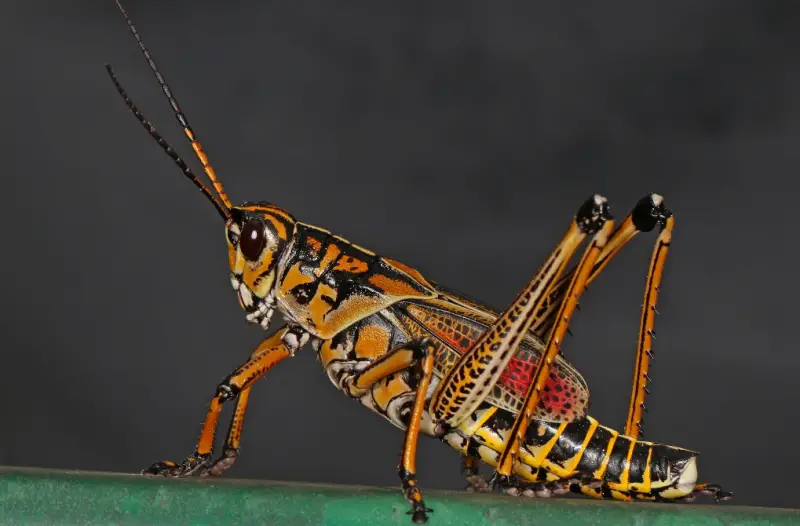
The Eastern Lubber Grasshopper (Romalea microptera) is one of the most distinctive and eye-catching insects in Alabama. Adults are large, slow-moving grasshoppers that can reach up to 3 inches (7.5 cm) in length. Their bodies display bright colors — typically yellow, orange, or red with black markings — serving as a warning to predators about their toxic defense. They have short wings and are incapable of sustained flight, preferring to walk or hop clumsily through vegetation.
These grasshoppers are found in warm, humid habitats across Alabama, including fields, gardens, forest edges, and roadsides. They are most active during late spring and summer, feeding on a wide range of plants such as wildflowers, grasses, and garden crops. Their bright coloration and large size make them easy to spot, but also a nuisance for gardeners.
The Eastern Lubber Grasshopper produces a mild toxin that deters predators, and when threatened, it releases a foul-smelling foamy secretion. Though harmless to humans in terms of venom or bite, contact with the secretion can irritate skin or eyes. Because of their tough exoskeleton and high reproduction rate, they can become locally abundant and cause damage to vegetation.
To control Lubber populations, remove egg clusters from soil, use natural predators like birds, or apply targeted insecticides early in the season. Despite their intimidating appearance and chemical defenses, these grasshoppers are an iconic part of Alabama’s summer landscape and a fascinating example of nature’s colorful warning systems.
Tips for Staying Safe from Dangerous Bugs in Alabama
Learn to Identify Hazardous Species
One of the most effective ways to stay safe from dangerous bugs in Alabama is to learn their key identifying features. Knowing how to recognize venomous spiders like the Black Widow and Brown Recluse, or aggressive insects such as Fire Ants and Yellowjackets, allows you to react appropriately before an encounter turns risky. Study their markings, sizes, and preferred hiding spots — for example, Black Widows hide in dark corners, while Fire Ants build noticeable mounds in open areas.
Keep Living Spaces Clean and Sealed
Most harmful bugs prefer cluttered, damp, or neglected spaces. Seal cracks in walls, doors, and windows to prevent entry, and keep basements, attics, and garages dry and organized. Trim vegetation near your home to eliminate nesting areas for wasps, ticks, and mosquitoes. Regularly inspect storage areas, outdoor furniture, and woodpiles, especially during Alabama’s humid summers, when pests are most active.
Use Personal Protection Outdoors
When hiking, gardening, or spending time outdoors, wear long clothing, closed-toe shoes, and insect repellent containing DEET or permethrin. Tuck pant legs into socks in tick-prone areas, and avoid sitting directly on grass or logs. For mosquito-heavy zones, use fans or citronella candles to create barriers against biting insects. These habits are especially important in Alabama’s warm, subtropical climate, where bugs remain active much of the year.
Respond Quickly to Bites and Stings
If bitten or stung, clean the area immediately with soap and water to prevent infection. Apply ice to reduce swelling, and take an antihistamine for itching or mild allergic reactions. Seek medical attention if symptoms worsen, especially if you experience dizziness, difficulty breathing, or severe pain. For known venomous species like the Southern Black Widow or Scorpion, professional medical care is always recommended. Quick, calm action can make a major difference in recovery outcomes.
FAQs About Dangerous Bugs in Alabama
What are the most dangerous bugs in Alabama?
Some of the most dangerous bugs in Alabama include the Black Widow Spider, Brown Recluse Spider, Fire Ant, Eastern Yellowjacket, and Bald-faced Hornet. Each poses unique risks, from venomous bites to painful stings. Additionally, disease-carrying insects such as Mosquitoes and Ticks can transmit illnesses like Lyme disease or West Nile virus.
Are scorpions in Alabama deadly?
No, scorpions in Alabama — mainly the Striped Bark Scorpion — are not deadly. Their sting is painful and can cause swelling or numbness but is rarely severe. However, individuals who are allergic or very young or elderly may experience stronger reactions and should seek medical care if stung.
How can I prevent bug infestations in my home?
Keep your home well-sealed, store food in airtight containers, and eliminate standing water. Regularly vacuum, clean storage spaces, and check for entry points around doors, windows, and plumbing. In Alabama’s humid environment, bugs often seek shelter indoors during heavy rain or heat, so maintaining cleanliness year-round is crucial.
What should I do if I’m bitten by a Brown Recluse Spider?
If bitten by a Brown Recluse, wash the bite area immediately with soap and water, apply a cold compress, and seek medical attention. Avoid applying heat or squeezing the wound, as this may spread the venom. Early treatment helps prevent severe tissue damage and infection.
Are mosquitoes in Alabama dangerous?
Yes. Alabama’s mosquitoes, including Aedes aegypti and Aedes albopictus, are capable of transmitting diseases such as West Nile virus, Zika virus, and chikungunya. Using repellents, removing standing water, and installing window screens are key preventive steps.
How can I avoid tick bites in Alabama?
Ticks thrive in Alabama’s wooded and grassy regions. To avoid bites, wear light-colored clothing, tuck pants into socks, and use repellents containing DEET or permethrin. After outdoor activity, check your body, clothing, and pets thoroughly. Prompt tick removal can prevent the spread of diseases like Lyme or Ehrlichiosis.
Do Velvet Ants (“Cow Killers”) really kill cows?
Despite their name, Velvet Ants do not kill cows. The nickname comes from the extreme pain their sting causes. They are solitary, non-aggressive wasps that sting only when provoked. Their vivid red-and-black coloration serves as a warning to potential predators.
When are bugs most active in Alabama?
Most bugs in Alabama are active from late spring through early fall, when humidity and temperatures are high. Mosquitoes and Fire Ants peak during summer, while spiders and ticks remain active into autumn. In warmer southern regions, some species persist even through mild winters.
Should I call pest control for dangerous insects?
Yes. If you discover venomous spiders, large wasp nests, or serious infestations of ants or ticks, contacting a licensed pest control professional is safest. Attempting removal without proper protection can lead to painful bites or stings. Professionals in Alabama are trained to handle the state’s most hazardous insect species effectively.


